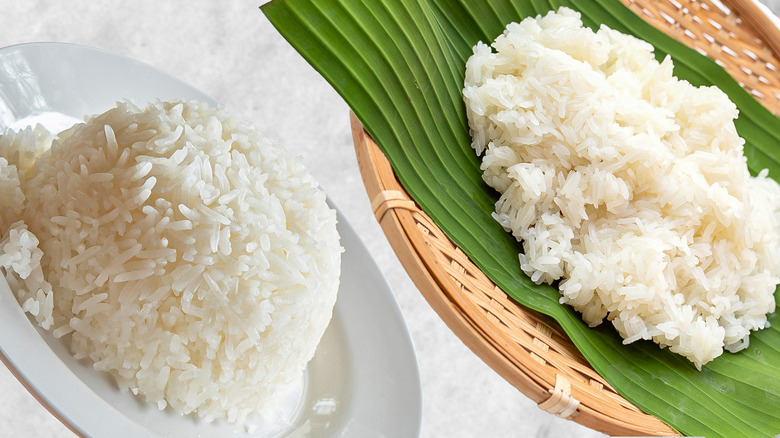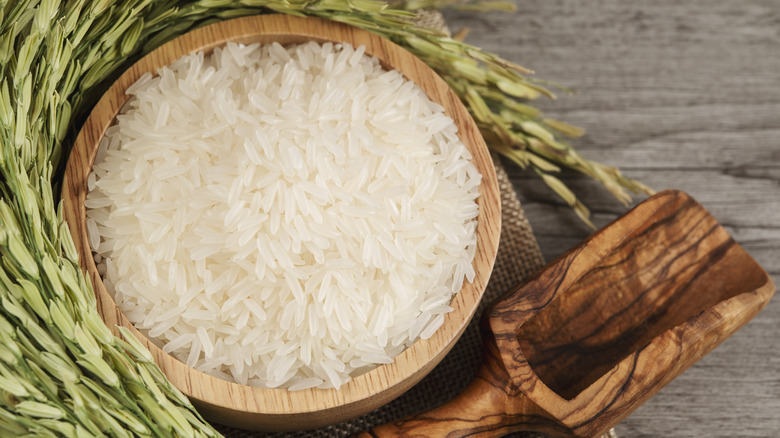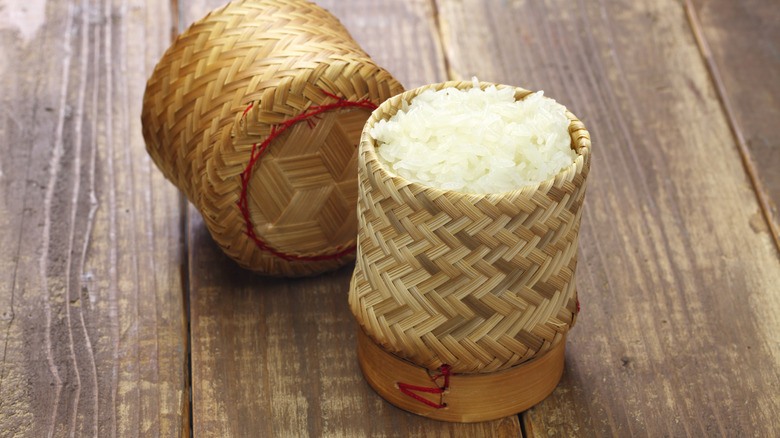The Distinct Difference Between Jasmine And Sticky Rice
The two types of rice you're likely to encounter at Thai restaurants — jasmine rice and sticky rice — couldn't be more different in texture and aroma. Jasmine rice, which you might enjoy on the side with your dinner, has distinct, firm grains when cooked. It's fluffy with a slightly soft bite and savory aroma. Then there's sticky (aka glutinous) rice that's sometimes served in a little woven basket. It clings fiercely together in clumps, making it perfect for sliding across your plate to get every last saucy bit of flavor from a dish. You've likely also seen sticky rice in the sweet Thai dessert coconut rice with mango. What causes these two types of rice to be so different when cooked turns out to be the kind of starch that's found in the grains.
You already know that rice is a starchy carbohydrate food, but there are many types of starch in foods. Rice can be divided into two big subspecies categories: japonica and indica. Japonica rice varieties are usually shorter grains that contain a high percentage of a very sticky starch called amylopectin. That makes japonica rice varieties (like Thai sticky rice) hold together after cooking. Jasmine rice is an example of the indica variety of rice. Indica has longer grains and less amylopectin starch. Less of that gluey starch helps the individual rice grains stay separate and loose, which translates into that pile of fluffy jasmine rice on the plate.
What is jasmine rice?
Jasmine rice is native to Thailand. The variety was a natural hybrid of local indica rice discovered by a farmer, Mr. Jaroon Tanthawut, in 1945. The new rice grains were exceptionally white, like the jasmine flowers they're named for, with a deliciously savory aroma when cooked, like popcorn or pandan leaves. By the late 1950s, jasmine rice (called hom mali in Thai) had become the predominant rice grown in Thailand thanks to its superior flavor, favorable growing characteristics, and long grains that become tender when cooked.
As an indica family rice, you can expect that it will maintain a fluffy, separate grain structure when it's cooked properly. Most recipes call for a ratio of 1 cup white jasmine rice to 1 ¼ or 1 ½ cups of water for stovetop cooking, depending on how soft you prefer your rice. Your rice cooker is perfect for preparing jasmine rice, too. You'll also find brown jasmine rice if that's your preference. It takes a little more water (about 1 cup rice to 2 cups water) and a longer simmer time due to the hull, but you will still get aromatic, perfectly distinct grains.
What is sticky rice?
Hailing from the northern area of Thailand, aptly named sticky rice clumps so well historians have discovered it's partially responsible for holding the Great Wall of China together. Food scientists think the variety was an early offshoot of the original rice plants from thousands of years ago based on genetics; it's been a staple food in Laos and northern Thailand for most of that time. Sticky rice, which is also known as sweet rice and glutinous rice, contains almost 100% amylopectin starch, far more than other cousins in the japonica family, which typically have around 80%.
Because amylopectin starch dissolves in water so well, the best (and most traditional) way to cook sticky rice is by steaming the soaked grains, not boiling them which can dissolve the grains. Soaking takes several hours and the steaming requires another 30 to 45 minutes, so this won't be the fastest way to get rice ready for dinner — but the reward of chewy, flavorful rice that you can pinch and wipe across your plate is well worth the wait. Be sure to make enough sticky rice for dessert, too!


